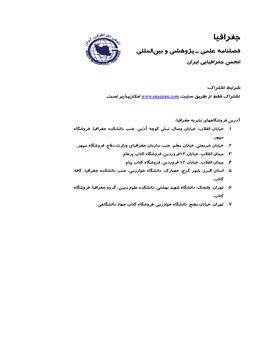The pathology of construction of pedestrian paths in Tehran city (case study: 15 Khordad square and Imam Hossein square)
Subject Areas :
1 -
2 -
Keywords: pathology, sidewalks, 15 Khordad square, Imam Hossein square.,
Abstract :
The presence of pedestrians in the sidewalks (pedestrian paths), have positive effect on the body of city, so that sidewalks are considered as one of the civil revitalization of urban centers. So building of sidewalks is one of the traffic restriction policies and is performed to improve the urban environment as a place for life. The aim of present study is pathology of construction of pedestrian paths in 15 Khordad square and Imam Hossein Square from viewpoint of body and economic (activity) components and this study has used including library and measuring method. The statistical society is two types. One of them is the all applications placed in the square body of 15 Khordad square and square body of Imam Hossein square and the other is the trades peoples of these studies districts which its volume is determined based on Kokaran formula respectively are 82 peoples and 140 peoples. The data in two sketches are analyzed based on descriptive indices by excel program. The obtained results have shown that we can not build a sidewalk in every street for better interactions of citizenry and we must more attention to environmental conditions.
1. آسیابی، محمد (1392 )، “میادین شهری نقدی بر یک فضای شهری در حال مرگ”، پژوهش ایران شهرساز، شماره 4، صفحات 8-1؛
2. آسیابی، محمد (1389)، میادین شهری معنا و مفهوم تا واقعیت آن در شهرهای ایران، تهران: طحان / هله؛
3. احمدی، ملیحه و حبیب، فرح (1387)، توسعه پایدار شهری با تأکید بر حرکت پیاده در آسیا، مجله علوم و فن آوری محیط زیست دوره دهم، شماره سوم . 13-1؛
4. اصغری زمانی، اکبر و شاهرخ¬زاد، ولی¬خواجه (1393)، “بررسی تأثیرات فرهنگی و اجتماعی عدم امنیت زنان در فضاهای شهری”، مهندسی فرهنگی، شماره 82؛
5. پاکزاد، جهانشاه (1384)، راهنمای طراحی فضاهای شهری در ایران، تهران: شرکت طرح و نشر پیام سیما؛
6. ثقفی اصل، آرش (1387)، “اهمیت و نقش پیاده¬راه در شبکه حمل و نقل شهر پایدار”، جستارهای شهرسازی شماره 26 و 27؛
7. خستو، مریم و سعیدی، رضوان نوید (1389)،“عوامل مؤثر بر سرزندگی فضای شهری، خلق یک فضای شهری، سرزنده با تأکید بر مفهوم (مرکز خرید پیاده”، هویت شهر، سال چهارم، شماره 6؛
8. حسینیون، سولماز (1383)، “مقدمه¬ای بر طراحی پیاده¬راهها، مجله شهرداری¬ها،، سال ششم، شماره 61؛
9. رفیعیان، مجتبی و دیگران (1390)، “امکان¬سنجی ارتقاء کیفیت محیط از طریق پیاده¬راه¬سازی محورهای شهری مورد: محور خیابان ارم بخش مرکزی شهر قم”، مطالعات و پژوهش¬های شهری و منطقه¬ای، شماره یازدهم: 56-41؛
10. زمستانی بالکانلو، معصومه و بشیر بیگی بابایی، (1392)، “نوستالژی میادین شهری”، پیام مهندس عمران، معماری و شهرسازی، شماره 59؛
11. سلطان¬زاده، حسین (1372)، فضاهای شهری در بافت¬های تاریخی ایران، تهران: دفتر پژوهش¬های فرهنگی؛
12. شماعی، علی و احمد پوراحمد (1384)، بهسازی و نوسازی شهری از دیدگاه علم جغرافیا، تهران: دانشگاه تهران؛
13. شوای، فرانسواز (1375)، شهرسازی تخلیات و واقعیات، مترجم: سیدمحسن حبیبی، تهران: دانشگاه تهران؛
14. کاشانی جو، خشایار (1393)، پیاده¬راه¬ها از مبانی طراحی تا ویژگی¬های کارکردی، چاپ دوم، تهران: آذرخش؛
15. کاظمی، مصطفی¬پور و دیگران (1390)، “تأثیر تصویر ذهنی گردشگران بر ارزش ادراک شده از شهرها ساحلی دریای خزر با تأکید بر نقش واسط کیفیت عوامل ادراک شده”، پژوهش و برنامه¬ریزی شهری، شماره 6؛
16. کریستوفر، الکساندرا و دیگران (1373)، تئوری جدید طراحی شهری، مترجم: محمدنقی¬زاده مطلق، تهران: نشر توسعه؛
17. فراهانی، پروین (1382)،“تسلط سواره، ظلم مضاعف بر پیاده”، مجله شهرداری¬ها، ضمیمه شماره 55، ویژه نامه شماره 11؛
18. فکوهی، ناصر(1390)، انسان¬شناسی شهری، تهران: نشر نی؛
19. قربانی، رسول و محمد جام¬کسری(1389)، “جنبش پیاده¬گستری، رویکردی نو در احیاء مرکز شهری؛ مورد مطالعه پیادهراه تربیت تبریز”، مطالعات و پژوهشهای شهری و منطقهای، شماره 6؛
20. مجتهد سیستانی، ارم(1387)، “شاخصه¬های کیفی مطلوبیت پیاده¬راه¬ها و خیابان¬های شهری”، چهاردهمین کنفرانس دانشجویان کشور و اولین کنفرانس بین¬المللی دانشجویان عمران، تهران؛
21. معینی، سیدمحمد مهدی(1385)، “افزایش قابلیت پیاده¬مداری، گامی به¬سوی شهری انسانی¬تر”، هنرهای زیبا، شماره 27 ، صفحات 16- 5؛
22. معینی، سیدمحمد مهدی(1391)، شهرهای پیاده مدار، تهران: آذرخش؛
23. هدمن، ریچارد و آندرویازوسکی (1381)، مبانی طراحی شهری، ترجمه راضیه رضازاده و مصطفی عباس زادگان، تهران: دانشگاه علم و صنعت ایران؛
24. lexander, cristoper and et. (1977), New Theory in urban Design, London: Oxford University;
25. Brambila, Roberto & Gianni longo, (1977), for pedestrians only: planning,Design and Management of traffic; free zones, New York, whitney library of Design;
26. cratan .f.(2008), Side walk in urban planning ,London : Oxford University.
27. Fehr peers (2011), signalized Interesction Enhan cements That Benefit pedestrians, New York ; National office: www.Americanwalls.org;
28. Forsyth, ,Ann and et. (2010), Meaurnig Walking and Cycling Using the PABS (Pdedestrian and Bicycling Survey) Approach: A Low-Cost Survey Method for Local Communities, Mineta Transportation Institute, san Joes stateuniners: www.transweb.sjsu.edu;
29. Gemzo, Lars and Ghel, Jan.(2006), The Copenhangen experience what the pedestrian wants, Ekim Tan Delft university of Tecnology photos;
30. Jacobs, Jane (1961), The failure of Town planning, New: vintage;
31. Litman, Todd. (2012), Evaluating Non – motorized Trans portation Benefits and cost, Bicycling and Transportation Research Record, Victoria Transport policy Instritute. www.vtpi.org/nmt;
32. Lock wood, J, stillings, T,.(1998), Traffic claming for crime reduction and neighborhood Revitalization, Inistitute of Transportation Engineers.www. Ite. Org/ traffiC;
33. Hass- khao, c ( 1993), Impact of pedestriantion and traffic colming on retailing: A Reriew of the eridence from Germany and uk, Transportation policy, vo1, 1,Issue 1,pp. 21-23;
34. Pike’ Lee. (2011), Generotion of Walking, Cycling And public Transport Trips: pilot study, New Zealand Transport Agency: www. Nzta. Govt. nz;
35. Speiregen, paul(1960), “The Architecture of Towns and cities”, The American Institute of Architecure.


